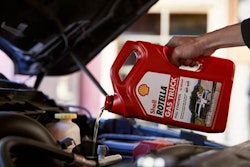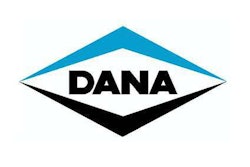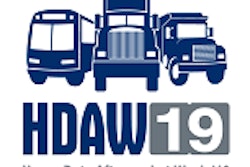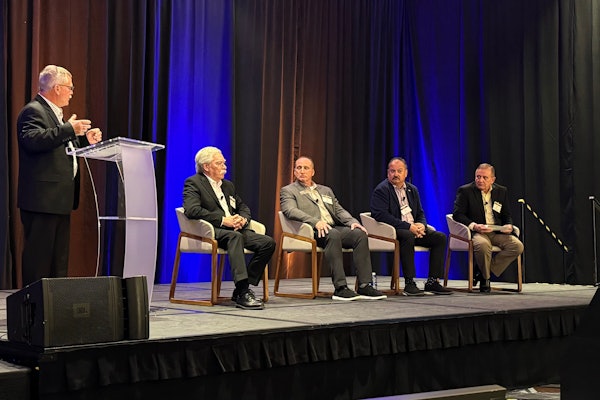The following comes from the January 2019 issue of Truck Parts & Service. To read a digital version of the magazine, please click the image below.

As the largest operating expense of truck ownership, fuel costs garner a lot of attention in the trucking community. Many large fleets work directly with OEMs to lobby and propose equipment specifications that will enable them to reduce their fuel expenditures. Owner-operators regularly evaluate and invest in aftermarket technology they believe is capable of lowering their fuel usage. Even company drivers are incentivized to alter their driving habits to achieve greater fuel economy for their employers.
Saving fuel means saving money.
One emerging fuel-efficient technology that could revolutionize how truck owners outfit their rigs to save fuel is platooning. Not yet commercially available, platooning continues to gain interest due to its exceptionally high fuel savings potential. Platooning also is unique in that it is the only developed fuel-efficient technology that requires more than one tractor-trailer to save fuel.
Platooning is “legalized drafting,” says Fred Andersky, director of customer solutions, controls, Bendix Commercial Vehicle Systems. It is a highly advanced, highly controlled driving strategy that links trucks together to reduce aerodynamic drag on all units. In 2016, the North American Council for Freight Efficiency (NACFE) released a Confidence Report on Two-Truck Platooning that estimated trucks platooned at a distance of 40 to 50 feet earn a fuel savings of 4 percent for the lead truck and 10 percent for the following truck.
With numbers like that, it’s easy to see why fleets and OEMs are eager to bring platooning to the on-highway market. It’s also easy to see why this is a great time for aftermarket businesses to do their homework on platooning. The advanced technology isn’t here yet, but it’s coming.
How does platooning work?
NACFE described platooning in its Confidence Report as “a catchall term for a broad range of possible implementations of fuel economy improvement through controlled operation of two or more trucks in tandem.”
The most visible platooning application is the one far most likely to enter the trucking industry in the immediate future — the two-truck platoon. These platoons have been in development by truck makers and tech companies for years, and last year multiple OEMs held controlled platoon tests on U.S. roadways. Two-truck platoons do not operate using a single vehicle system or computer but, instead, connect a series of advanced safety systems from two tractors together to enable them to travel at the same speed and distance apart on a roadway.
With platooning, “everything starts with the braking system,” says Jon Morrison, president, Americas, WABCO.
The two-truck platoon systems currently being tested in North America require the most advanced tractor braking systems available in the marketplace. Anti-lock brakes are required, air disc brakes are strongly recommended, Andersky says.
These brake systems also must be linked through electronic control units (ECU) with forward collision mitigation radar and electronic stability control systems to dedicated short-range communication radios. The radios and their adjoining systems are necessary for the platoon, as their near instantaneous transfer of vehicle acceleration and braking data from the lead truck to the rear truck ensure both vehicles remain an equal distance apart at all times — including during emergency braking events.
The brakes are engaged “before you can even get your foot to the pedal,” Andersky says.
Who is going to platoon?
Like most fuel-efficient technologies, platooning was designed for the open road. Nearly all two-truck platoon testing done to this point has been conducted on suburban or rural U.S. interstates where trucks could reach the speeds necessary to minimize aerodynamic drag and maximize fuel savings.
Regional and national fleets with multiple trucks traversing the same daily routes stand to gain the most from platooning, says Mike Roeth, executive director, NACFE.
“We found the mega fleets are the ones looking to try it,” he says. “They won’t be able to platoon every mile, but if they can platoon two trucks for 400 miles, they’ll see some payback.”
Non-interstate platooning seems less likely, experts say. Some state highways may provide the conditions necessary to achieve the fuel economy benefits of platooning but it is unlikely there are many fleets with multiple units running those routes at the same time.
Additionally, Roeth says the stop-and-go nature and route uniqueness of urban pickup and delivery makes inner-city platooning highly unlikely.
But unlike other aero-based fuel economy products, which only provide payback in ideal operating conditions, the safety systems required for platooning are advantageous at all times.
“That added layer of driver safety will be there all the time,” says Keith Brandis, vice president of product planning, Volvo Trucks North America.
When will platooning be available?
Morrison estimates nearly 30 states currently allow some level of truck platoon testing, and OEMs and component suppliers believe state governments are open to legalizing platooning for on-highway operations in the coming years.
But bringing platooning to the North American market will require more than legalization. While stability control and collision mitigation radar are now standard features on most new Class 8 tractors, the technology required to connect the ECUs for those and other safety systems to a platoon exists only at a developmental level.
Says Brandis, “We’re working with prototype parts, not parts off the shelf.”
Brandis adds Volvo continues to adapt and improve its platooning solution in its controlled highway testing with FedEx. Daimler Trucks North America (DTNA) also has used occasional on-highway tests to complement its Proving Ground and closed track development work, says Paige Kean, DTNA corporate communications manager.
Peloton, the independent connected vehicle technology company that helped bring platooning to the forefront of the industry in 2011, announced in 2016 that its proprietary system would be available by the end of 2017. As of this article’s publication date that system still has yet to be released.
Both Andersky and Sandeep Kar, chief strategy officer at vehicle and fleet tracking firm Fleet Complete, believe platooning likely is a few years away.
“I could see a period of two to five years before its fully available, and probably 10 years before it really starts gaining roots,” says Kar. “[Adoption] is not going to happen overnight.”
Andersky submits late 2020 or early 2021 as a potential introduction time while acknowledging full scale acceptance as a longer-term reality. Though Roeth says when that acceptance comes, “you’re going to notice it … two trucks traveling 50 feet apart is not invisible.”
What impact will platooning have on the aftermarket?
When platooning does arrive, it may offer a helpful sales bump for brakes and other braking-related products.
Andersky says a big reason for that is the following distance required for a fuel-efficient platoon. Two tractor trailers traveling 40 to 50 feet apart at 65 mph absolutely must have OEM performance-level brake system components and friction material. The risks associated with alternative products are too great, he says.
“We’re asking drivers to do something we’ve asked them not to do for 50 years and that’s follow really close,” he says.
Adds Morrison, “Those trucks are going to need the highest quality components.”
Andersky also believes truck owners who choose to platoon will need to increase the scope of their daily pre- and post-trip inspections and shorten their PM intervals to ensure all brake system components are operating at peak performance at all times. Any tractor that participates in a platoon with worn or inferior brakes puts both tractors in the platoon and nearby motorists at risk.
Closer inspections include tires, too. Improperly inflated and balding tires can struggle to maintain proper traction with road surfaces and alter stopping distances.
There’s also the matter of the vehicle safety systems themselves. Morrison says WABCO’s OnGuard advanced driver assistance collision mitigation system was built to require minimal maintenance, but that doesn’t mean the system is indestructible. He says inclement weather or road debris obstructing the system’s radar and camera systems could impact its performance, as could incidental contact to the systems during other vehicle service.
Like Andersky, Morrison says detailed inspections of these systems would be required for any platoon-capable tractor, adding WABCO offers “training and instructional tools to make sure nothing jeopardizes the performance of the system.”
But Kar doesn’t see these service requirements as being impediments to acceptance for any fleets considering the technology. Platooning may require specific components be installed during maintenance stops but it shouldn’t require additional maintenance.
“I don’t think maintenance [expenses] are really a priority for any fleets considering platooning,” he says. “Their focus is on the fuel economy benefits and how many of their routes and tractors are good fits” for platooning.
Kar adds, “The larger the platoon, the larger the fuel savings are going to be.”










